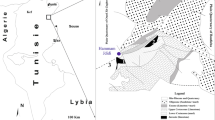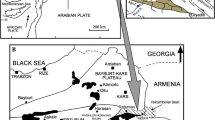Abstract
Recent tufa deposition has been taking place on a 500 m-long natural bridge on the Göksu River in the Yerköprü region, southern Konya, Turkey. The Karasu spring arises from the Karasu normal fault, flows over this natural bridge and drops down from the end of the bridge, forming a spectacular waterfall. There is a dense CO2 degassing from this water and the H2CO −13 content is 506,3 mg/L at the orifice and 549 mg/L on the waterfall, but it drops almost to half at the bottom of the waterfall. The field observation and chemical data showed that the deposition of the studied tufa was related only to the water derived from the Karasu spring. At the active waterfall area, tufa deposition takes place on the cascade, in small and large ponds and in channels. People living in the area build canals for irrigation and milling purposes, which cause the spreading of tufa deposits to other than the main course of the Karasu spring water. The most common types of facies are the different phytotherm facies, but stromatolitic, micritic and phytoclastic facies are also present to a lesser amount. The δ13C content of the tufa deposits ranges from 1,6 to − 3,3 and δ18O contents from − 9,6 to − 11,5. The higher δ13C values of the Yerköprü tufa deposits indicate that the carbonate-rich water of the Karasu spring originated from a carbonate aquifer. The isotopic values of the studied tufa samples are similar to those of travertine, but the Karasu water is interpreted as cold water. Therefore, it may be considered as “travitufa”.














Similar content being viewed by others
References
Andrews JE (2006) Paleoclimatic records from stable isotopes in riverine tufas; synthesis and review. Earth Sci Rev 75:85–104
Andrews JE, Brasier AT (2005) Seasonal records of climate change in annually laminated tufas: short review and future prospects. J Quat Sci 20:411–421
Andrews JE, Riding R, Dennis PF (1993) Stable isotopic compositions of recent cyanobacterial carbonates from the British Isles: local and regional environmental controls. Sedimentology 40:303–314
Arenas C, Jones B (2017) Temporal and environmental significance of microbial lamination: insights from Recent fluvial stromatolites in the River Piedra, Spain. Sedimentology 64:1597–1629
Arenas C, Gutierrez F, Osacar C, Sancho C (2000) Sedimentology and geochemistry of fluvio-lacustrine tufa deposits controlled by evaporite solution subsidence in the central Ebro Depression, NE Spain. Sedimentology 47:883–909
Arenas C, Cabrera L, Ramos E (2007) Sedimentology of tufa facies and continental microbialites from the Paleogene of Mallorca Island (Spain). Sed Geol 197:1–27
Arenas C, Azquez-Urbez M, Pardo G, Sancho C (2014) Sedimentology and depositional architecture of tufas deposited in stepped fluvial systems of changing slope: lessons from the Quaternary Añamaza valley (Iberian Range, Spain). Sedimentology 61:133–171
Arenas-Abad C, Vazquez-Urbez M, Pardo-Tirapu G, Sancho-Marcen C (2010) Fluvial and associated carbonate deposits. In: Alonso-Zarza AM, Tanner LH (eds) Developments in sedimentology: carbonates in continental settings: facies, environments and processes. Elsevier, Amsterdam, pp 133–175
Arp G, Bissett A, Brinkmann A, Cousin S, De Beer D, Fried T, Mohr KI, Neu TR, Reimer A, Shiraishi F, Stackebrandt E, Zippel B (2010) Tufa-forming biofilms of German karst water streams: microorganisms, exopolymers, hydrochemistry and calcification. In: Pedley HM, Rogerson M (eds) Tufas and speleothems: unravelling the microbial and physical controls, vol 336. Geological Society, London, pp 83–118
Baker A, Smart PL, Ford DC (1993) Northwest European paleoclimate as indicated by growth frequency variations of secondary calcite deposits. Paleogeogr Paleoclimatol Paleoecol 100:291e301
Brasier AT, Andrews JE, Kendall AC (2011) Diagenesis or dire genesis? The origin of columnar spar in tufa stromatolites of central Greece and the role of chironomid larvae. Sedimentology 58:1283–1302
Capezzuoli E, Gandin A, Pedley M (2014) Decoding tufa and travertine (fresh water carbonates) in the sedimentary record: the state of the art. Sedimentology 61:1–21
Chen J, Zhang DD, Wang S, Xiao T, Huang R (2004) Factors controlling tufa deposition in natural waters at waterfall sites. Sed Geol 166:353–366
Delikan A, Mert M (2014) Depositional properties of geomorphologically controlled Holocene tufas in a valley from Hadim-Yerköprü (Konya-Southern Turkey). GeoFrankfurt 2014 Earth System Dynamics, Abstract Volume Page, 38, Frankfurt-Germany
Delikan A, Orhan H, Ekici G, Sayin U, Ozmen A (2017) Yerköprü (Hadim-Konya) bölgesinde tufa çökellerinin ESR metodu ile yaşlandirilabilirliği hakkında ilk bulgular. Sedimantoloji Çalışma Grubu 2017 Çalıştayı (Karasal Çökelme Sistemleri), Abstract Book, p. 76, Rize-Turkey
Della Porta G (2015) Carbonate build-ups in lacustrine, hydrothermal and fluvial settings: comparing depositional geometry, fabric types and geochemical signature. Microbial carbonates in space and time: implications for global exploration and production, vol 418. Geological Society, London
Domínguez-Villar D, Vazquez-Navarro JA, Cheng H, Edwards RL (2011) Freshwater tufa record from Spain supports evidence for the past interglacial being wetter than the Holocene in the Mediterranean region. Global Planet Change 77:129–141
Ford TD, Pedley HM (1996) A review of tufa and travertine deposits of the world. Earth Sci Rev 41:117–175
Gandin A, Capezzuoli E (2008) Travertine versus calcareous tufa: distinctive petrologic features and stable isotopes signatures. Ital J Quat Sci 21:125–136
Glover C, Robertson AHF (2003) Origin of tufa (cool-water carbonate) and related terraces in the Antalya area, SW Turkey. Geol J 38:329–358
Gradzinski M (2010) Factors controlling growth of modern tufa: results of a field experiment. Geol Soc Spec Pub 336:143–191
Guo L, Riding R (1998) Hot-spring travertine facies and sequences, Late Pleistocene Rapolano Terme, Italy. Sedimentology 45:163–180
Guo L, Riding R (1999) Rapid facies changes in Holocene fissure ridge hot spring travertines, Rapolano Terme, Italy. Sedimentology 46:1145–1158
Hancock PL, Chalmers RML, Altunel EC, Akır Z (1999) Travitonics: using travertines in active fault studies. J Struct Geol 21:903–916
Hassan KM (2014) Note on the isotopic geochemistry of fossil-lacustrine tufas in carbonate plateau: a study from Dungul region (SW Egypt). Chem Erde 74:285–291
Henchiri M (2014a) Quaternary paludal tufas from the Ben Younes spring system, Gafsa, southwestern Tunisia: interactions between tectonics and climate. Quat Int 338:71–87
Henchiri M (2014b) Sedimentology of Quaternary calcareous tufas from Gafsa, southwestern Tunisia. Arab J Geosci 7(5):2081–2209
Henning GJ, Grun R, Brunnacker K (1983) Speleothems, travertines and paleoclimates. Quat Res 20:1229
Jones B, Renaut R (2010) Calcareous spring deposits in continental settings. In: Alonso-Zarza AM, Tanner LH (eds) Continental settings: facies, environments and processes., pp 177–224
Karaisaoğlu S, Orhan H (2018) Sedimentology and geochemistry of the Kavakköy travertine (Konya, central Turkey). Carbonates Evaporites. https://doi.org/10.1007/s13146-018-0436-z
Khalaf FI (2017) Occurrence and genesis of Quaternary microbialitic tufa at Hammam Al Ali, Oman. J Afr Earth Sci 129:417–426
Kosun E (2012) Facies characteristics and depositional environments of Quaternary tufa deposits, Antalya, SW Turkey. Carbonate Evaporites 27:269–289
Magnin F, Guendon JL, Vaudour J, Martin P (1991) Les travertins: accumulations carbonate Esassociees aux systemes karstiques sequences sedimentaires et paleoenvironnements quaternaries. Bull Soc Geol Fr 162(3):585–594
Martìn-Algarra A, Martìn-Martìn M, Andreo B, Juliá R, González-Gómez C (2003) Sedimentary patterns in perched spring travertines near Granada (Spain) as indicators of the palaeohydrological and palaeoclimatological evolution of a karst massif. Sed Geol 161:217–228
Melón P, Alonso-Zarza AM (2018) The Villaviciosa tufa: a scale model for an active cool water tufa system, Guadalajara (Spain). Facies 64:5
Nicoll K, Sallam ES (2017) Paleospring tufa deposition in the Kurkur Oasis region and implications for tributary integration with the River Nile in southern Egypt. J Afr Earth Sci 136:239–251
O’Brien GR, Kaufman DS, Sharp WD, Atudorei V, Parnell RA, Crossey LJ (2006) Oxygen isotope composition of annually banded modern and mid- Holocene travertine and evidence of paleomonsoon floods, Grand Canyon, Arizona, USA. Quat Res 65:366–379
Orhan H, Kalan F (2015) Sedimentological characteristic of Quaternary Aydıncık tufa (Mersin-Türkiye). Carbonates Evaporites 30:451–459
Ozdemir A, Nalbantcilar MT (2002) The investigation of mass transfer in the Karasu karstic aquifer, Konya, Turkey. Hydrogeol J 10:656–661
Ozkul M, Gokgoz A, Horvatincic N (2010) Depositional properties and geochemistry of Holocene perched springline tufa deposits and associated spring waters: a case study from the Denizli province, Western Turkey. In: Pedley HM (ed) Tufas and speleothems: unravelling the microbial and physical controls, vol 336. The Geological Society, London, pp 245–262
Özkul M, Gökgöz A, Sandor K, Baykara MO, Shen CC, Chang YW, Kaya A, Hançer M, Aratman C, Taylan A, Örü Z (2014) Sedimentological and geochemical characteristics of a fluvial travertine: a case from the eastern Mediterranean region. Sedimentology 61:291–318
Pedley HM (1990) Classification and environmental models of cool freshwater tufas. Sed Geol 68:143–154
Pedley HM (2009) Tufas and travertines of the Mediterranean region: a testing ground for freshwater carbonate concepts and developments. Sedimentology 56:221–246
Pedley M, Andrews J, Ordonez S, García del Cura MA, Gonzolez Martín JA, Taylor D (1996) Does climate control the morphological fabric of freshwater carbonates? A comparative study of Holocene barrage tufas from Spain and Britain. Paleogeogr Paleoclimatol Paleoecol 121:239–257
Pedley M, Gonzalez Martín JA, Ordonez S, García del Cura MA (2003) Sedimentology of Quaternary perched springline and paludal tufas: criteria for recognition, with examples from Guadalajara Province, Spain. Sedimentology 50:23–44
Peng X, Jones B (2013) Patterns of biomediated CaCO3 crystal bushes in hot spring deposits. Sediment Geol 294:105–117
Pentecost A (2005) Travertine. Springer, Berlin, p 445
Pentecost A, Viles HA (1994) A review and reassessment of travertine classification. Geogr Phys Quat 48:305–314
Pentecost A, Whitton BA (2000) Limestones. In: Whitton BA, Potts M (eds) The ecology of cyanobacteria. Kluwer, Amsterdam, pp 257–279
Pisciotta A, Tiwari AK, De Maio M (2018) An integrated multivariate statistical analysis and hydrogeochemical approaches to identify the major factors governing the chemistry of water resources in a mountain region of northwest Italy. Carbonates Evaporites. https://doi.org/10.1007/s13146-018-0452-z
Pla-Pueyo S, Viseras C, Henares S, Yeste M, Candy I (2017) Facies architecture, geochemistry and paleoenvironmental reconstruction of a barrage tufa reservoir analog (Betic Cordillera, S. Spain). Quat Int 437:15–36
Richter DK, Immenhauser A, Neuser RD, Mangin A (2015) Radiaxial-fibrous and fascicular-optic Mg-calcitic cave cements: a characterization using electron backscattered diffraction (EBSD). Int J Speleol 44:91–98
Sancho C, Arenas C, Vázquez-Urbez M, Pardo G, Lozano MV, Peña-Monné JL, Hellstrom J, Ortiz JE, Osácar MC, Auqué L, Torres T (2015) Climatic implications of the Quaternary fluvial tufa record in the NE Iberian Peninsula over the last 500 ka. Quat Res 84:398–414
Sanders D, Wertl W, Rott E (2011) Spring-associated limestones of the Eastern Alps: overview of facies, deposystems, minerals, and biota. Facies 57:395–416
Teboul PA, Durlet C, Gaucher EC, Virgone A, Girard JP, Curie J, Lopez B (2016) Origins of elements building travertine and tufa: new perspectives provided by isotopic and geochemical tracers. Sed Geol 334:97–114
Toker E (2017) Quaternary fluvial tufas of Sarıkavak area, southwestern Turkey: facies and depositional systems. Quat Int 437:37–50
Vazquez-Urbez M, Arenas C, Pardo G (2012) A sedimentary facies model for stepped, fluvial tufa systems in the Iberian Range (Spain): the Quaternary Piedra and Mesa valleys. Sedimentology 59:502–526
Zamarreno I, Anadon P, Utrilla R (1997) Sedimentology and isotopic composition of Upper Paleocene to Eocene non-marine stromatolites, eastern Ebro Basin, NE Spain. Sedimentology 44:159–176
Zhang DD, Zhang Y, Zhu A, Cheng X (2001) Physical mechanisms of river waterfall tufa (travertine) formation. J Sediment Res 71:205–216
Acknowledgements
This work was supported by the Selcuk University Scientific Research Fund (BAP, Project Number: 11201066). This article was produced from the master thesis of Mehmet Mert, supervised by Arif Delikan We thank Prof. Dr. Hükmü Orhan for constructive comments that improved the manuscript. We also thank the anonymous reviewers for their valuable comments.
Author information
Authors and Affiliations
Corresponding author
Rights and permissions
About this article
Cite this article
Delikan, A., Mert, M. Depositional and geochemical characteristics of geomorphologically controlled recent tufa deposits on the Göksü River in Yerköprü (Konya, southern Turkey). Carbonates Evaporites 34, 441–459 (2019). https://doi.org/10.1007/s13146-018-0477-3
Accepted:
Published:
Issue Date:
DOI: https://doi.org/10.1007/s13146-018-0477-3




